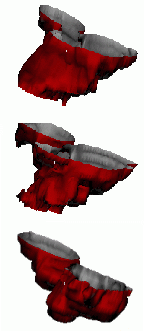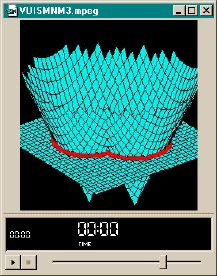BERKELEY -- Physicians and surgeons are constantly confronted with
questions about the invisible. How big is a brain tumor? Is it shrinking with treatment?
How thin is a heart-chamber wall, and how much blood does the heart pump? What is the
exact shape and volume of a liver?
 Three frames from a movie of a beating heart showing
the walls and interior of the chambers
|
A fast new way to compute three-dimensional models of internal organs and other
anatomical features has been developed by Ravi Malladi and James Sethian of the Department
of Energy's Lawrence Berkeley National Laboratory. Both are in the Mathematics Department
of Berkeley Lab's Computing Sciences Directorate; Sethian is also a professor of
mathematics at the University of California, Berkeley.
"We want to make the task of visualizing and reconstructing medical shapes easy
for doctors," says Malladi, who notes that noninvasive imaging has made great
advances in recent decades. Whether from x rays or ultrasound or magnetic-resonance
imaging or computed tomography, however, even the best images have problems. They are flat
-- at best a series of map-like slices through the anatomical region of interest -- and
they are usually noisy, like a TV picture plagued with snow.
"One of the first things we set out to do was make cleaner images without
destroying essential information," says Malladi. "Of course trained physicians
and medical technicians can find the boundaries even in noisy images, and indeed hospitals
hire interns to sit in front of computers and painstakingly click out the edges on series
of digital images. The challenge is to create a program that can make these decisions in
automatic fashion."
Malladi and Sethian have used their methods to make images of organs with shapes as
intricate as those of the human brain; from sonograms they have modeled the fetus in the
womb; they have made movies of a pumping heart, relating blood flow in and out of the
chambers to the thickness of the heart walls.
"Now all a physician has to do is click once or twice inside the region of
interest and the computer program will build a model in a few seconds," Malladi says.
The new methods make medical images useful to doctors in real time, aiding fast, well
informed decisions for effective treatment.
The way Malladi and Sethian build cleaner images is closely related to the way they
build three-dimensional models from a series of flat images. An "implicit
representation of curves" is the underlying mathematical approach, a form of
partial-differential equations pioneered by Sethian which tracks boundaries as they evolve
in space and time. "Level Sets" and "Fast Marching" are two methods
important in recovering medical shapes. (See background information below.)
Level Sets is a method of modeling curves and solids by incorporating an extra
dimension -- viewing the representation from above, as it were. Fast Marching is a method
of approximating the position of curves and surfaces moving under a simple "speed
law," which attracts the evolving curve to a boundary and closely relates it to the
regularity of the emerging shape. With these methods a computer algorithm can determine
the internal and external boundaries of anatomical solids more quickly and less
ambiguously than traditional ways of interpreting visual information.
The process begins when the physician uses the computer to plant a visual seed in the
image to be modeled. "Even a single point, represented by a computer mouse click, can
be thought of as a very small circle or sphere," Malladi says. From that point an
increasingly complex shape starts to grow. Knowing when to stop, however, depends on the
algorithm recognizing edges that are often hard to read.
The trick lies in mathematically adjusting the speed of the growing curve. As the curve
advances, it encounters changes in the gray-scale values of the pixels in the image. Where
changes are small from one pixel to the next, the curve moves quickly -- the algorithm
assumes there is no nearby boundary -- but where changes are large, the curve senses a
boundary and slows down. Too-abrupt changes in curvature are also smoothed by the
calculation.
Since the mathematical view is always from one dimension "above" the shape
being modeled, a complex 3-D model can be quickly constructed, with the propagating
boundary curve easily working its way around holes and voids. What's inside and outside a
complex solid can be modeled separately. Models constructed at different moments in time
produce movies of 3-D shapes in action.
Malladi's and Sethian's recent results were published in Proceedings of the
Sixth International Conference on Computer Vision, Mumbai (Bombay), India,
January, 1998. Movies of anatomical model construction can be found on the web at http://www.lbl.gov/~malladi.
The Berkeley Lab is a U.S. Department of Energy national laboratory located in
Berkeley, California. It conducts unclassified scientific research and is managed by the
University of California.
Level Sets and Fast Marching, combined with other mathematical techniques, have yielded
quick, efficient, and manageable programs for anatomical images.
Imagine tracking the changing boundary of two rings of fire burning outward in dry
grass. One way to follow the changing boundary between the burned area and the unburned
area is to track points on each expanding circle. But as soon as the circles overlap, all
the points formerly on boundaries but now in the burned area must be abruptly discarded,
which makes the calculation messy.

An online movie illustrating Level Sets and Fast Marching
|
Now instead of two circles on a plane, picture two upright cones, partly overlapping:
the original two rings of fire lie on the boundary where a level plane slices through the
surfaces of both cones near their tips. Move the plane up, and the circles grow together.
The boundary follows automatically, with no points to be tracked or arbitrarily discarded
-- only a level to be determined, which describes the evolving curve.
It's easy to imagine adding a third dimension to a two-dimensional curve; it's hard to
picture a fourth spatial dimension associated with a volume. Yet mathematically it is no
more difficult to use this Level Sets approach with solids.
What drives a curve's evolution, whether in two dimensions or three, is a "speed
law." Typically a speed law might move a point on a boundary faster in regions of
tight curvature and slower in less curved regions. This would have the effect of smoothing
out transitions where the curve changes direction abruptly, an effect known as
"viscosity" because it resembles the slow, smooth transitions of a thick liquid
like honey.
Fast Marching equations come into play in making choices to compute the evolving curve
most efficiently. Curvature can be negative (inward) or positive (outward). Any closed
curve, no matter how complex, whose points move perpendicularly inward in the positive
regions and outward in the negative regions, at curvature-dependent speed, will inevitably
form a circle -- which in turn will shrink to a point.
To build smooth maps and 3-D images of internal organs, however, the curve or surface
has to move in the opposite direction, starting from small geometric shapes or solids and
evolving outward to complex ones. Therefore a speed law is written containing two terms,
one that attracts the curve or surface to the boundary of the target object and another
that closely relates the curve or surface to the regularity of the evolving shape -- for
example by adding a little "viscosity" from changes in curvature. In this way a
complex shape can be quickly and accurately bounded and filled in.
The principles of Level Sets and the method's many applications are discussed in
"Tracking interfaces with level sets," by James Sethian, American
Scientist, May-June 1997, page 254. A discussion with online video can
be found on the web at http://math.berkeley.edu/~sethian/level_set.html.